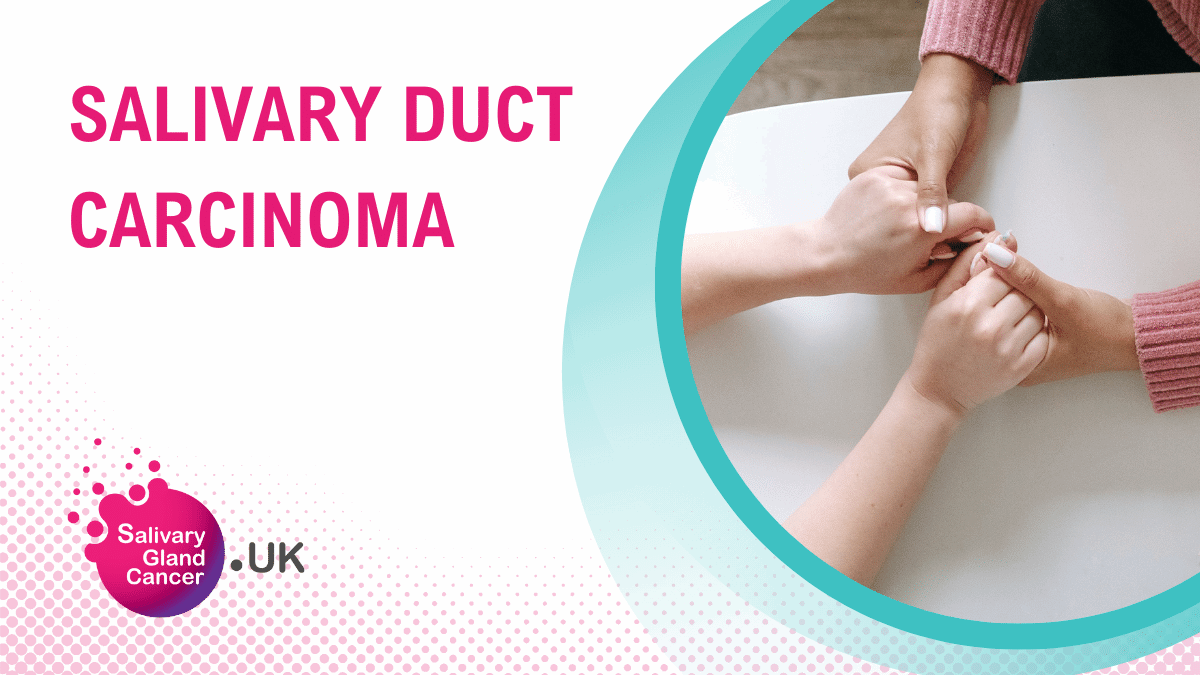Salivary Duct Carcinoma (SDC)
Salivary Duct Carcinoma
Salivary Duct Carcinoma (SDC) is a rarer type of salivary gland cancer. One or two in a hundred salivary gland cancers are of this type.
SDC most commonly occurs in people in their 60’s or 70’s and is more common in men. It typically starts in the parotid salivary gland located between the ears and the jaw but can form in any of the major or minor salivary glands in the head, throat, and windpipe.
Unlike most salivary gland cancers, SDC is usually a faster growing (high-grade) type. It often metastasises (spreads from the original tumour site) early to nearby lymph nodes or further parts of the body (distant sites). This can make surgery and/or radiotherapy aimed at curing the cancer challenging, and the cancer has a high risk of returning later in life even with successful surgery.
All cancers have characteristics called markers, and in SDC these are very important to determining treatment options. Around three quarters of SDC are androgen receptor positive and two fifths of SDC overexpress the HER2 marker, with about a third overexpressing both. Both markers have drugs that can target them, and these are currently the best treatment options for widespread SDC.
Sometimes SDC expresses rarer markers that also have treatments available. Chemotherapy is more effective in SDC than other salivary gland cancers, but it is still quite resistant with only one in five people having a positive response in their cancer.
'Androgen receptor overexpression' or 'AR+'
Patients with androgen receptor overexpression in their cancer may benefit from androgen receptor blockers. Androgen receptor overexpression is also known as androgen receptor positive (AR+).
The main drug used to treat androgen receptor overexpression is bicalutamide. This is a daily tablet commonly used in prostate cancer, but it can be used in any cancer that overexpresses androgen receptors. Usually, bicalutamide is paired with an injection given every month to 3 months of a luteinising hormone-releasing hormone (LHRH) agonist. Examples of LHRH agonists include triptorelin and leuprorelin. The tablet and injection together are known as combined androgen receptor blockade.
Combined androgen receptor blockade (CARB) has been shown to be effective in treating salivary gland cancers with androgen receptor overexpression. About two in every five patients treated with CARB will have their cancer reduced in size and about three-quarters will at least have their cancer stabilised.
CARB may be funded by the NHS and your cancer doctor may be able to help you access these therapies by applying for NHS funding. They may also be available through a clinical trial investigating androgen receptor blockade. Alternatively, these therapies are also available through private care.
CARB blocks the androgen testosterone. Therefore, CARB is generally better tolerated by women as they have less testosterone to start with. Most of the side effects are related to reduced testosterone function in the body.
Reference
Fushimi C., Tada Y., Takahashi H., et al. (2018) A prospective phase II study of combined androgen blockade in patients with androgen receptor-positive metastatic or locally advanced unresectable salivary gland carcinoma. Annals of Oncology 29, 979–984.
'HER2 overexpression' or 'HER2+'
Patients with HER2 overexpression in their cancer may benefit from anti-HER2 therapies.
The main available options are based on a drug called trastuzumab. It is also known by the brand name Herceptin. These options include:
trastuzumab alone,
trastuzumab alongside a chemotherapy drug called docetaxel,
trastuzumab with pertuzumab,
ado-trastuzumab emtansine (also called TDM1).
TDM1 is a newer type of treatment called an antibody-drug conjugate, which intends to deliver a chemotherapy drug directly to the cancer to reduce the side effects associated with traditional chemotherapy.
All of these treatments have been shown to be effective in HER2-overexpressing salivary gland cancers, but the studies included very small numbers of people and may have inaccurate results. Currently, these studies suggest that at least six in every ten patients treated will have their cancer significantly reduced in size.
These treatments are not routinely available with NHS funding unless more research is published to support their use. Your cancer doctor may be able to help you access anti-HER2 therapies by applying to the drug manufacturer (known as “compassionate access”) or by referring you to be considered in a clinical trial investigating anti-HER2 therapies. These therapies are also available through private care.
There are other anti-HER2 therapies in a group called biosimilars. These are versions of an antibody drug made by a different manufacturer. Due to the way antibody drugs are made, there is no guarantee that these biosimilar drugs work in the same way as the original. However, they usually have a lower cost and may be easier for you doctor to help you access. An example would be trastuzumab dttb, known by the brand name Ontruzant. Biosimilar drugs have very little evidence for use in salivary gland cancers, but they are used successfully in other types of cancer.
References
Kurzrock R., Bowles D.W., Kang H., et al. (2020) Targeted therapy for advanced salivary gland carcinoma based on molecular profiling: results from MyPathway, a phase IIa multiple basket study. Annals of Oncology 31, 412–421.
Li B.T., Shen R., Offin M., et al. (2019) Ado-trastuzumab emtansine in patients with HER2 amplified salivary gland cancers (SGCs): Results from a phase II basket trial. JCO 37, 6001–6001.
Takahashi H., Tada Y., Saotome T., et al. (2019) Phase II Trial of Trastuzumab and Docetaxel in Patients with Human Epidermal Growth Factor Receptor 2–Positive Salivary Duct Carcinoma. JCO 37, 125–134.
Useful resources
Read more about how to get your tumour profiled and add to the research biobank at the Christie Hospital in Manchester, UK here:
- Gene profiling or tumour profiling or genomic testing - Salivary Gland Cancer UK
- Donate tissue to the Biobank - Salivary Gland Cancer UK
Last updated April 2024

